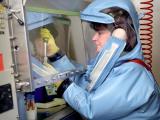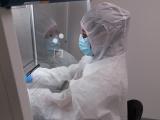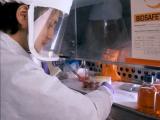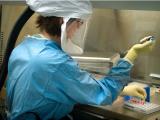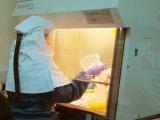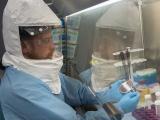An external panel of experts concluded that the US Centers for Disease Control and Prevention (CDC) has a weak commitment to laboratory safety and that a sizable share of lab workers are afraid to report safety lapses, among other problems, according to a report released this week.
The panel, which was assigned to review the agency's safety performance in the wake of mishaps last year, said the CDC risks losing its credibility because of the safety problems. It said lab safety training is inadequate and inconsistent and that CDC labs should be required to undergo safety reviews and accreditation by outside groups.
"Leadership commitment toward safety has been inconsistent and insufficient at multiple levels," the report states. "Safety, including lab safety, is viewed by many as something separate from and outside the primary missions of public health and research. Safety is not integrated into strategic planning and is not currently part of the CDC culture, enterprise-wide."
The report was completed in January but was not posted on the CDC Web site until this week. The agency said today that it generally agrees with the committee's recommendations and is already working on implementing many of them. It also said the committee's findings are based mostly on information gathered last August and September.
Panel assignment followed safety breaches
The expert panel, a working group of the Advisory Committee to the Director (ACD) of the agency, was established last July after two safety breaches came to light.
One involved the contamination of a culture of low-pathogenic avian influenza virus with a highly pathogenic H5N1 virus and shipment of the culture to an external lab, which happened in January 2014 but didn't come to light until months later. The other, in June 2014, involved the transfer of potentially viable Bacillus anthracis from a biosafety level 3 (BSL-3) lab to a BSL-2 lab, risking exposure for dozens of workers. Neither incident led to any known infections or illnesses.
Yet another incident happened in December, when some material that may have contained live Ebola virus was mistakenly moved from a BSL-4 lab to a BSL-2 lab, leading to possible exposure of a technician who worked with the material in the less secure lab. The technician remained healthy.
The 11-member review panel is chaired by Kenneth Berns, MD, PhD, of the University of Florida in Gainesville, and co-chaired by Joseph Kanabrocki, PhD, of the University of Chicago. It is formally known as the External Laboratory Safety Workgroup (ELSW) of the ACD. The group visited CDC labs, conducted a lab-safety culture survey, and met with internal staff and leadership.
Regarding the CDC leaders' commitment to lab safety, the panel found that employees don't understand the CDC's response to accidents or how the response should be communicated to agency units outside the affected labs. "Disturbingly, the negative responses peak among those individuals who work at BSL3 and 4, especially among those holding a master's degree."
To improve the lab safety climate, the ELSW recommended that the CDC leadership communicate a "CDC way" that features "the performance of responsible science practiced in a consistently safe manner."
'Fragmented' approach to training
Regarding training, the panel said, "The organizational complexity of the CDC has contributed to a fragmented, inconsistent approach to laboratory safety training. The majority of training is now conducted online. . . . The CDC does not have its own hands-on directly observed centralized safety training program."
The group recommended that the agency establish a standardized training curriculum for all lab personnel along with standard methods for evaluating skills.
On the matter of reporting incidents, the ELSW's survey revealed that "a significant percentage of CDC staff have concerns about experiencing negative repercussions, either personally or more generally to the Agency, as a result of reporting incidents involving exposures to pathogenic organisms or other hazardous materials."
In particular, some workers in labs that handle federally designated select agents fear regulatory or other negative consequences if they report mishaps. For example, when the B anthracis incident occurred in June, many scientists were concerned that there were violations of the Select Agent rules, but there "were no mentions of people being similarly concerned with biosafety," the panel said. It added that other findings also suggested more concern about biosecurity requirements than biosafety.
The panel said the CDC needs to establish "a culture of responsible science and accountability. This culture of responsible science will require prompt and accurate reporting of incidents or breaches in standard protocol without fear of reprimand or punishment. (Not reporting should be considered a breach of responsibility.)"
Structural problems
In other findings, the experts said the CDC's organizational structure does not support maintaining a culture of shared responsibility and consistent practices across different units. It noted that two key safety oversight groups are outside the chain of command for CDC centers and divisions.
In addition, "Risk assessments of proposed research activities are either not being done in a standardized manner or are not being done at all." For example, the Institutional Biosafety Committee reviews only recombinant DNA research.
While calling the CDC "an incredibly capable organization," the panel said, "We are very concerned that the CDC is on the way to losing credibility. The CDC must not see itself as 'special.' The internal controls and rules that the rest of the world works under also apply to CDC."
The committee concluded by recommending an external review and accreditation process for CDC labs and calling on the agency to formally track and report its progress in following up on the group's recommendations.
CDC says improvements are under way
In a statement sent by spokesman Tom Skinner in response to the report today, the CDC said, "CDC has done much work to address the recommendations from the external and internal assessments. Anecdotal feedback from lab scientists suggests that the improvements are well received and are having a positive effect."
The agency said that although the ELSW presented its findings to the full advisory committee in January, it began its review of CDC's laboratories in August and did most its assessment at the CDC in August and September. "So the report reflects observations of the workgroup made several months ago."
Kanabrocki, the panel's co-chair, confirmed that timeline today. In e-mail comments to CIDRAP News, he added, "The ELSW is being updated regularly concerning the CDC response to the recommendations of the ACD. Among numerous other activities initiated in response to the ACD recommendations, I know that recruitment for a new position, an Associate Director of Laboratory Science and Safety that will report directly to the CDC Director, is well underway."
The CDC statement said that when the ELSW presented its findings in January, CDC Director Tom Frieden, MD, MPH, "noted that while some of the recommended actions can be implemented relatively quickly, others will take time to implement, including those relating to organizational structures and funding.
"Significant progress has already been made, and some decisions will be left for the new ADLSS [associate director for lab science and safety] to address and have input into these key issues. The bottom line is that CDC agrees with the proposed actions, is implementing them, and is deeply appreciative of the ELSW's efforts and expert advice."
Newly adopted precautions
The agency provided a list of steps it has taken so far, including:
- Establishing additional safeguards as part of standard operating procedures for all material intended for inactivation and removal from high containment labs
- Creating and reinforcing effective and redundant systems and controls for protocols and procedures, including inactivation and transfer of biological materials and access to laboratories
- Standardizing laboratory protocols to include additional safety elements
- Ensuring adherence to laboratory quality and safety protocols
- Implementing new procedures and training of CDC laboratory staff that will keep pace with advancing technologies and protocol demands
- Developing a standardized approach for conducting risk assessments for work with biological materials
- Developing enhanced competency-based laboratory safety training programs
- Reviewing and monitoring the implementation of training policies and procedures for new and existing staff
The statement also listed several additional steps it is taking or plans to take, including enhancing biosecurity and biosafety training and clarifying policies on the disposition of leftover samples when staff members leave their jobs.
See also:
CDC ELSW report, posted Mar 16
General CDC lab safety information
Information about the ELSW
Jun 19, 2014, CIDRAP News story "CDC probes anthrax exposure at its research labs"
Aug 15, 2014, CIDRAP News story "CDC probe of H5N1 cross-contamination reveals protocol lapses, reporting delays"
Dec 29, 2014, CIDRAP News story "CDC lab tech still healthy after possible Ebola exposure"




